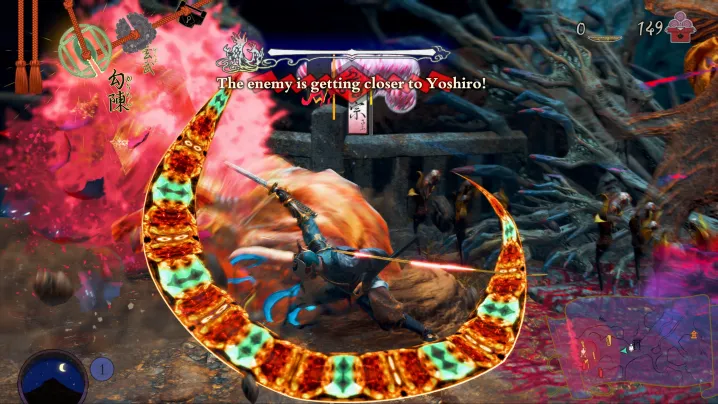“Kunitsu-Gami: Path of the Goddess is unlike anything else you'll play in 2024, and that's why it's one of the year's best games.”
- Unique action-strategy blend
- Level twists keep battles fresh
- Strong progression
- Feels like a true folktale
- Gorgeous visual design
- Tedious base building
I knew Kunitsu-Gami: Path of the Goddess was special when I hit the oddball strategy game’s third level, Yuan Cavern.
Until this point, all of the levels had been simple affairs of guiding a maiden from one Torii gate to another along a preset path, and defending her along the way by commanding powered-up villagers and fighting enemies head-on. While Yuan Cavern tasked me to do the same, it introduced a light mechanic that impacted my strategy. I could no longer just crowd villagers at the Torii gate to kill Seethe as soon as they came out.
My villagers couldn’t attack in the dark, but could light lanterns along the path to illuminate incoming enemies. I had to think more delicately about how far I had to move the goddess forward each day so I was in a place where I could properly defend her. Kunitsu-Gami is a unique hybrid of action and tower defense, but levels like that almost turn battles into an ingenious puzzle.
Kunitsu-Gami constantly encourages players to stay engaged, whether that be because they have to plan out the maiden’s path, actively fight enemies during the night, or craft their own interpretation of its mostly dialogue-free narrative. While some parts of the journey can get repetitive, Kunitsu-Gami rewards those who pay attention, learn its deep systems, and adapt to whatever wacky situation it throws at them. There’s nothing else quite like it.
Modern folklore
In Kunitsu-Gami, players control a mystical being named Soh, who must guide a maiden named Yoshiro from the top of a mountain to the bottom after it is overrun by “defilement.” Across 14 stages, players clear handcrafted levels of defilement and transform each area into a base afterward. The further players get down the mountain, the clearer it becomes that the defilement is hurting Yoshiro too. With no dialogue outside of some narration and occasional callouts from Yoshiro, Kunitsu-Gami leaves players to decide what the quiet tale is about as if it were a classic folktale.

From the cutscenes and some collectibles, I gather that it takes place in a world where humans took advantage of the natural environment and paid the price by enabling the defilement to take over the mountain. While the villagers can work together to overcome this great defilement, it comes at a price. Kunitsu-Gami is a game about how sacrifice is required to incite great change, and it’s up to us as individuals to think about what we’re willing to give up to get what we want.
While this can be tough, Kunitsu-Gami also seems optimistic that there’s something worth saving on the other side of it all. Of course, that’s just one interpretation of the adventure, as players can interpret its narrative in quite a few different ways. This narrative approach, along with the fantastical aesthetics and an insightful trickle of collectible lore, turns Kunitsu-Gami into a modern fairy tale that players can relay to one another like folklore.
Kunitsu-Gami’s bold presentation alone makes it one of the most memorable titles of 2024.
That feeing is backed up by Kunitsu-Gami’s stunning aesthetics. From the character design to the fantastical color scheme, the entire experience is vibrant, clearly pulling from the look and feel of iconic Japanese woodprint paintings. It’s clever with its color shorthand, too. Something is helpful if it’s pink (the color of Yoshiro), but anything painted in deep red is a threat.
Character and enemy designs are also immediately striking; it’s easy to keep paying attention during these battles because everything is so pretty to look at. Layer in a mesmerizing soundtrack on top of that, and Kunitsu-Gami’s bold presentation alone makes it one of the most memorable titles of 2024.
A unique take on tower defense
Kunitsu-Gami’s gameplay reflects the struggle and planning required to move on and evolve. In most of its levels, the goal is to guide Yoshiro from one side of a linear map to another along a spirit path during the day. Players carve this path using crystals, which are obtained by clearing defilement around levels and fighting Seethe. Those enemies pop out at night and Yoshiro will stop moving during their attack phase. Players can take as long as they need to guide Yoshiro to the defiled Torii at the other end of the level, but they must also fight hard to ensure that she doesn’t take too much damage at night before she gets there.

Soh can actively fight enemies with their sword in combat, which is most similar to Capcom’s underrated and long-dormant Onimusha series. Soh is quite the action hero on their own, thanks to a wealth of flashy combos and special abilities players have access to. Still, Soh needs help from villagers. They can be freed from poison cocoons during the day and assigned roles during a battle. These range from Woodcutters, who melee attack enemies quickly for not a lot of damage, to the Ascetic, which can slow the movement of enemies and leave them vulnerable to strikes.
Players can command these villagers to stand on specific parts of the map, and they will automatically attack any enemies that come within range (picture a more violent Pikmin). As I unlocked more classes throughout the adventure, it was up to me to mix and match all of the villagers I freed to create the most effective combinations at night to protect Yoshiro. She’s the “tower” that needs defending, putting a clever spin on a familiar formula. Villagers act as the defenses around her as they need to be positioned properly to kill all the Seethe before they even get close. Of course, that’s easier said than done, and that’s not because the location of Yoshiro moves over time.
I don’t think any two players will complete a level in exactly the same way.
Assigning a role to a villager costs crystals, the same currency required to carve the spirit path. I could create some powerful units, like the attention-grabbing Sumo Wrestler, early on in a level, but that would mean I’d have to spend more nights fighting Seethe. Conversely, I could immediately carve a spirit path to the exit, but would likely have to use less powerful villagers to fight off the Seethe at night. Each level, and even each night, presents a unique challenge, so I don’t think any two players will complete a level in exactly the same way.
This push and pull is at the center of every Kunitsu-Gami level, and then each stage layers in a unique twist on the formula. Some levels forgo traveling between the Torii entirely, instead asking players to gather a certain amount of crystals to free Yoshiro from corruption or fight a more powerful boss while simultaneously defending Yoshiro from smaller enemies. While it’s easy for tower defense games to get repetitive, Kunitsu-Gami circumvents that by finding ways to keep each level fresh, whether that’s with toxic pools, dark caverns, or enemies coming at Yoshiro from both directions.
Back to base building
While I enjoyed the variance of every level in Kunitsu-Gami early on, I worried that the game wouldn’t offer enough in terms of long-term progression. Thankfully, that wasn’t the case. Around the halfway point of the game, it introduces systems that let me enhance the abilities of Soh and villagers by spending a currency called Musubi. I had to complete challenges, find hidden chests with a Thief villager, and build bases around the mountain to collect it. Every time I beat a stage, it became a base for me to build up and earn rewards from.
Once players enter a settlement, they can assign villagers to build structures around the base and return a mission or two later to reap the rewards. This is the primary way to acquire Musubi, alongside other more lore-based items and Mazo Talismans that can further enhance Soh’s abilities. While I was grateful to finally have an aspect of the game that added a lot more progression and depth, it winds up being a bit of tedious busy work.

While Soh’s relatively slow movement speed isn’t an issue in more tactical battles, it became one for me when I had to go through upwards of five to 10 bases between every stage to collect resources and start new construction. I understand that Capcom wanted to highlight Kunitsu-Gami’s beautiful level design and demonstrate how these villages are working together to heal, but I couldn’t help but wish this was all relegated to a single, easy-to-navigate menu rather than a 10-plus minute interlude between every stage.
Thankfully, that’s the single low point in an otherwise fantastic adventure. I’ve appreciated how unabashedly weird Kunitsu-Gami looked ever since its reveal in 2023, and I’m happy to report that the final release offers an experience not quite like anything else out there. While collecting materials at bases between stages could be a slog, when I was in a battle, Kunitsu-Gami was thoroughly engaging because of its unique core gameplay loop that Capcom constantly found new ways to build upon.
Kunitsu-Gami: Path of the Goddess was tested on an Xbox Series X.





